Article of the Month -
August 2005
|
Opportunities for Surveyors in Modern Land Markets
Prof. Ian P. WILLIAMSON, Australia

 This article in .pdf-format
This article in .pdf-format
1) This article was
for the first time presented at the FIG/GSDI Conference in Cairo, Egypt,
16-21 April 2005.
Key words: Land administration, land market, cadastre.
1. INTRODUCTION
Land surveyors are experts in designing, building and managing the
spatial component of our land administration systems (LAS). They are
experienced in creating, describing and defining land parcels and the
associated rights and restrictions. One of the primary reasons that society
requires these skills is to support an efficient and effective land market,
which will promote economic development where rights in land can be bought,
sold, mortgaged and leased. However as professionals, along with land
administration officials and associated legal professionals, we assume that
we understand land markets and that we have developed appropriate
professional skills to serve the needs of those markets.
Unfortunately this is often not the case. There is little documentation
on how to design and build a land market or on the development and growth of
land markets. It is ironic that surveyors pride themselves on working from
the “whole to the part”, yet in the case of land markets there is little
effort given to designing the land markets and then designing the land
administration system and supporting spatial skills to support them.
Our current cadastral skills are appropriate for simple land markets
where the focus is traditional land development and simple land trading,
however land markets have evolved dramatically in the last 50 years and have
become very complex, with the major wealth creation mechanism focused on the
trading of complex commodities. As with simple commodities such as land
parcels, all commodities require quantification and precise definition (de
Soto, 2000). While land surveyors have not embraced the administration of
complex commodities to a significant degree (although I wish to acknowledge
and applaud those that have), these modern complex land markets offer many
opportunities for surveyors if they are prepared to capitalize on their
traditional measurement and land management skills.
This paper shows that the growth of markets in complex commodities is a
logical evolution of our humankind to land relationship and the evolving
cadastral and land administration systems. The paper concludes that the
changing humankind to land relationships, the need to pursue sustainable
development and the increasing need to administer complex commodities offer
new opportunities for land surveyors.
2. EVOLUTION OF LAND ADMINISTRATION SYSTEMS
|
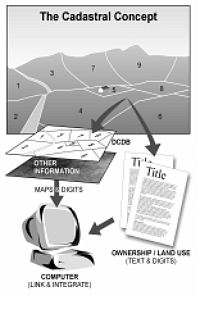
Figure 1: The Cadastral Concept (FIG, 1005) |
The cadastral concept shown in Figure 1 (FIG, 1995) is simple and
clearly shows the textual and spatial components that are the focus of
land surveyors and land registry officials. However while the cadastral
concept is simple, implementation is difficult and complex. While this
model is still a useful depiction of a cadastre, it does not show the
evolving and complex rights, restrictions and responsibilities that a
modern society demands in order to deliver sustainable development
objectives. To understand this evolution it is worth considering the
changing humankind to land relationship over the centuries. Even though
Figure 2 depicts a western example of this evolving relationship, a
similar evolution can be plotted for all societies. In this diagram the
evolution from feudal tenures, to individual ownership, the growth of
land markets driven by the Industrial Revolution and the impact of a
greater consciousness about managing land with land use planning being a
key outcome, and in recent times the environmental dimension and more
recently the social dimension in land, are highlighted (Ting and
Williamson, 1999a). Historically an economic paradigm drove land markets
however this has now been significantly tempered by an environmental and
more recently a social paradigm. Simply the humankind to land
relationship in any society is not stable but is continually evolving.
|
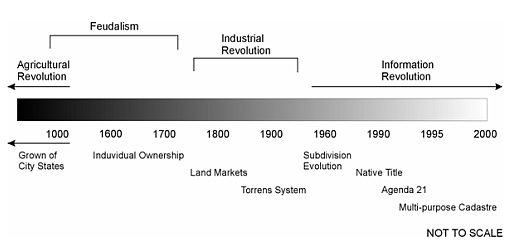
Figure 2: Evolution of people to land relationship
(Ting and Williamson, 1999a)
In turn most civilisations have developed a land administration response
to this evolving humankind to land relationship. Figure 3 depicts the
evolution of these land administration responses over the last 300 years or
so in a western context. The original focus on land taxation expanded to
include the support for land markets, then land use planning and over the
last decade or so has expanded to provide a multi-purpose role to support
sustainable development objectives (Ting and Williamson, 1999b).
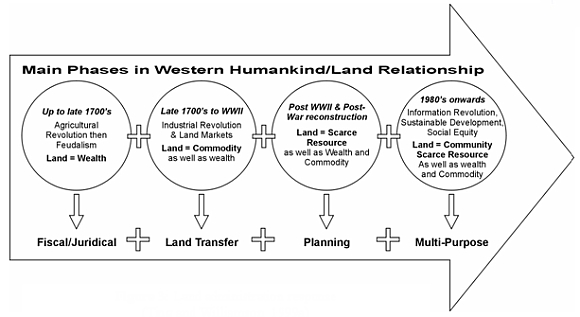
Figure 3: Land administration response
(Ting and Williamson, 1999b)
Current land administration systems were developed since the middle 19th
century to define simple land commodities and to support simple trading
patterns (buying, selling, leasing and mortgaging), particularly by
providing a remarkably secure parcel titling system, an easy and relatively
cheap conveyancing system, and reliable parcel definition through attainable
surveying standards.
Arguably, countries like Australia and their European counterparts have
led the world in adapting their LAS to support land parcel marketing. Major
innovations of the Torrens system of land registration and strata titles for
example are copied in many other countries. However, because of the pace of
change, the capacity of LAS to meet market needs has reduced. The land
market of, say, 1940 is unrecognisable in today’s modern market. After WW II
new trading opportunities and new products were invented. Vertical villages,
time shares, mortgage backed certificates used in the secondary mortgage
market, insurance based products (including deposit bonds), land
information, property and unit trusts and many more commodities now offer
investment and participation opportunities to millions either directly or
through investment and superannuation schemes. The controls and restrictions
over land have become multi-purpose, and aim at ensuring safety standards,
durable building structures, adequate service provision, business standards,
social and land use planning, and sustainable development. The replication
of land related systems in resource and water contexts is demanding new
flexibilities in our approaches to administration (see Wallace and
Williamson, 2004 for more details).
Australian LAS that service parcel based trading and related market
activities were overhauled in the 30 years commencing in 1970 to:
- comply with National Competition Policy
- reorganise the 19th century legislative structures establishing single
office - single function administrations (Surveyor General, Registrar
General, Valuer General) with modern management and performance enhanced
organisational structures
- provide opportunities for more competitive professional services and
private sector involvement, and
- capitalize on opportunities available from digital and web
technologies.
The combination of new management styles, computerization of activities,
creation of databanks containing a wealth of land information, and improved
interoperability of valuation, planning, address, spatial and registration
information allowed much more flexibility. However, Australian LAS remain
creatures of their history of state and territory formation. They do not
service national level trading and are especially inept in servicing trading
in new commodities. The result is that modern societies, which are
responding to the needs of sustainable development, are now required to
administer a complex system of overlapping rights, restrictions and
responsibilities relating to land.
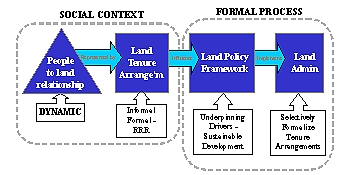
Figure 4: Formalisation of tenures
(Dalrymple, Wallace and Williamson, 2004)
Modern societies are also now realising that there are many rights,
restrictions and responsibilities relating to land, which exist but have not
been formalised by governments for various policy or political reasons. This
does not mean these rights don’t exist but that they simply have not been
formalised. A good example is the recognition of indigenous aboriginal
rights in land in Australia in the 1980s. Prior to the Mabo and Wik
decisions and the resulting legislation in Australia, indigenous rights did
not formally exist. However this does not mean these rights did not exist,
albeit informally. This process of formalising tenure and rights,
restrictions and responsibilities in land is depicted in Figure 4.
An understanding of both formal and informal rights is important as we
move to develop land administration systems that are sensitive to
sustainable development objectives. A model for a modern land administration
system (Enemark et al, 2004) that draws on the above principles is shown in
Figure 5.

Figure 5: Land Administration Arrangements
(Enemark, Williamson and Wallace, 2004)
At the same time land markets have also evolved from systems for simple
land trading to trading complex commodities such as mortgage backed
certificates and water rights. Our understanding of the evolution of land
markets is limited but an appreciation is necessary if we are going to
maximise the potential of trading in complex commodities by developing
appropriate land administration systems that can support this trading
(Wallace and Williamson, 2004). Figure 6 shows the various stages in the
evolution of land markets from simple land trading to markets in complex
commodities. The growth of a complex commodities market showing examples of
complex commodities is presented diagrammatically in Figure 7.
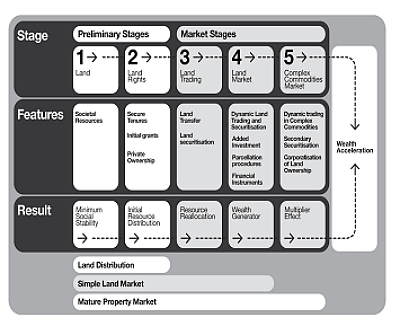
Figure 6: Evolution of land markets
(Wallace and Williamson, 2004)
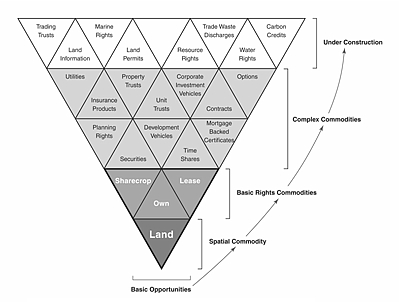
Figure 7: Complex commodities market
(Wallace and Williamson, 2004)
3. BUSINESS OPPORTUNITIES FOR SURVEYORS
This brief review of the evolution of land administration systems and
land markets shows that the traditional concept of cadastral parcels
representing the built environmental landscape is being replaced by a
complex arrangement over-lapping tenures reflecting a wide range of rights,
restrictions and responsibilities and that a new range of complex
commodities building on this trend have emerged. To a large extent these
developments have been driven by the desire of societies to better meet
sustainable development objectives. There is no reason to believe that this
trend will not continue as all societies better appreciate the need to
manage the environment for future generations.
Many surveyors are highly skilled in accommodating environmental
considerations into land developments. But how many surveyors have moved
outside their comfort zone of focusing on the boundaries of individual
cadastral parcels?
While future markets of complex commodities will continue to rely on the
underlying cadastre and land administration system, how many surveyors will
embrace the definition and management of complex commodities that don’t rely
on the traditional cadastral boundaries?
4. CONCLUSION
In this paper I have attempted to show that the humankind to land
relationship is dynamic with the result that the land administration
response to managing this relationship is also dynamic and is continually
evolving. A central objective of the resulting land administration systems
is to serve efficient and effective land markets. Because of sustainable
development and technology drivers, modern land markets now trade in complex
commodities, however our current land administration systems and the
majority of the skills of land surveyors are focused on the more traditional
processes supporting simple land trading. I believe the growth in complex
commodities offers many opportunities for surveyors if they can capitalize
on their traditional measurement and land management skills.
I don’t have all the answers or a road map for surveyors to play a
greater role in the management of complex commodities markets, although I do
believe it offers many opportunities and is a logical extension of their
traditional measurement and land management skills.
The challenge is not only to surveyors but also land registry, land
administration and land information officials to design and build modern
land administration systems that will better support the creation,
administration and trading of complex commodities. Unfortunately without
these systems modern economies will have difficulty meeting sustainable
development objectives and achieving their economic potential.
ACKNOWLEDGEMENT
I wish to gratefully acknowledge the assistance of my colleagues in the
Centre for Spatial Data Infrastructures and Land Administration, Department
of Geomatics, University of Melbourne in the preparation of the article, and
particularly the assistance and ideas from my colleague Ms Jude Wallace. I
also wish to acknowledge that an earlier version of this paper was presented
at the 4th Trans Tasman Surveyors Conference, Auckland , New Zealand, 13-16
October, 2004.
REFERENCES
- Dalrymple, K., Wallace, J. and Williamson, I.P. 2004 Rural Land
Arrangements to Address South East Asian Policy Development. Submitted to
the International Planning and Development Review.
- De Soto, Hernando, 2000, The Mystery of Capital: Why Capitalism
Triumphs in the West and Fails Everywhere Else, Bantam Press,
London, 235 pp
- Enemark, S., Wallace, J. and Williamson, I.P. 2004. Land
administration arrangements. Submitted to the Spatial Sciences Journal,
Spatial Sciences Institute, Australia.
- FIG, 1995. The FIG Statement on the Cadastre. International
Federation of Surveyors, FIG Publication No 11.
http://www.fig7.org.uk/publications/cadastre/statement_on_cadastre.html
Accessed 8th August, 2004
- Ting, L., Williamson, I.P. Grant, D. and Parker, J. 1999a.
Understanding the Evolution of Land Administration Systems in Some Common
Law Countries. The Survey Review, Vol. 35, No. 272, 83-102.
http://www.geom.unimelb.edu.au/research/publications/IPW/EvolnLandAdmin_
SurvReview_.pdf
Accessed 8th August, 2004.
- Ting, L. and Williamson, I.P. 1999b. Cadastral trends: A synthesis.
The Australian Surveyor, Vol. 4, No. 1, 46-54.
http://www.geom.unimelb.edu.au/research/publications/IPW/Cadastral
TrendsSynthesis.html
Accessed 8th August, 2004
- Wallace, J. and Williamson, I.P. 2004. Building land markets. Accepted
for publication in the Journal of Land Use Policy.
BIOGRAPHICAL NOTES
Ian Williamson is Head, Department of Geomatics, University of
Melbourne, Australia, where he is Professor in Surveying and Land
Information, and Director of the Centre for Spatial Data Infrastructures and
Land Administration. He is Chair, PCGIAP-Working Group 3 (Cadastre). He was
Chairman of Commission 7 (Cadastre and Land Management) of the International
Federation of Surveyors (FIG) 1994-98 and Director, United Nations Liaison
1998-2002. His teaching and research interests are concerned with designing,
building and managing land administration, cadastral, and land and
geographic information systems in both developed and developing countries.
CONTACTS
Prof Ian Williamson
Director, Centre for SDIs and Land Administration
Head, Department of Geomatics
Department of Geomatics, The University of Melbourne
AUSTRALIA
Email: ianpw@unimelb.edu.au
 |































